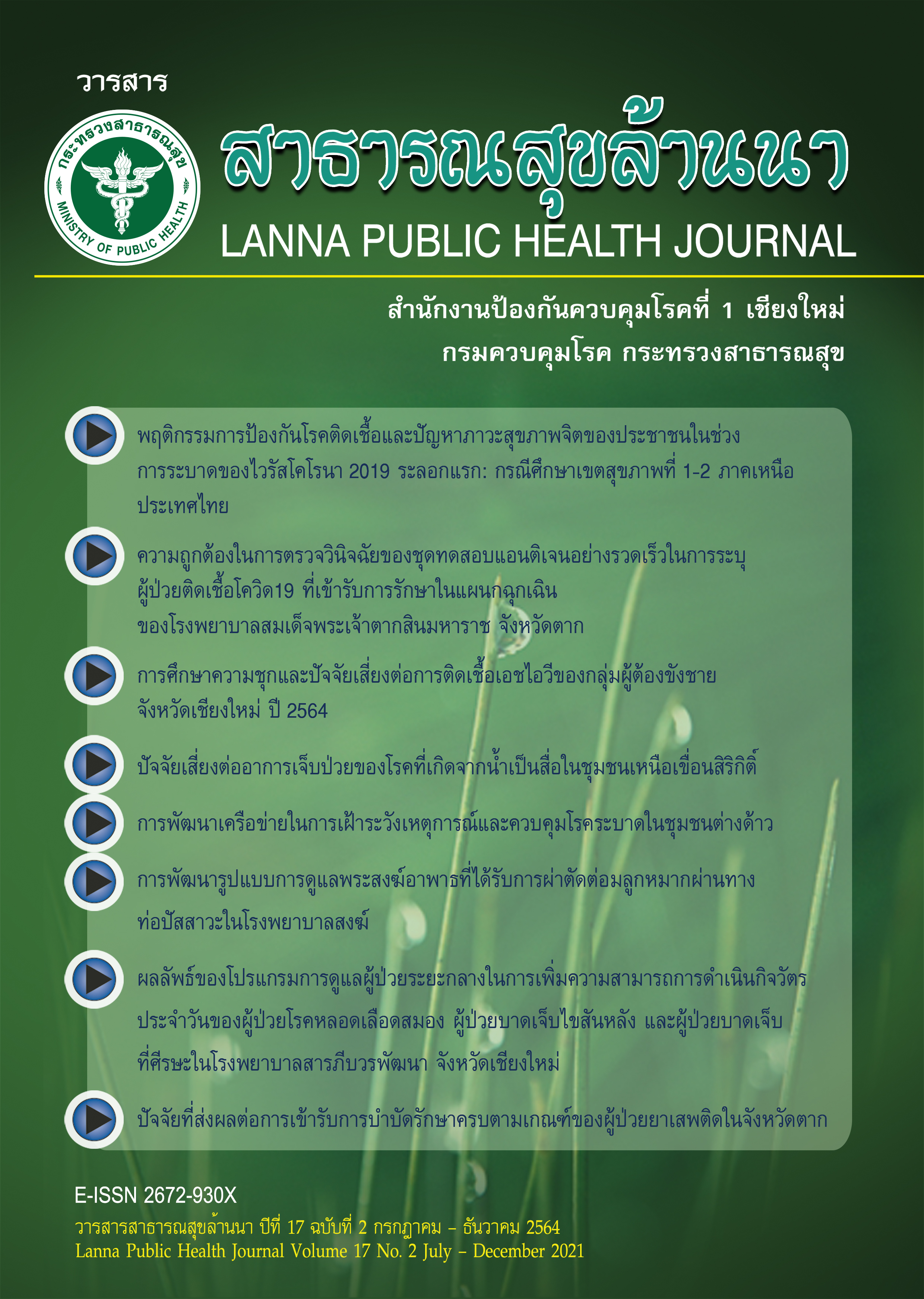ความถูกต้องในการตรวจวินิจฉัยของชุดทดสอบแอนติเจนอย่างรวดเร็วในการระบุผู้ป่วยติดเชื้อโควิด 19 ที่เข้ารับการรักษาในแผนกฉุกเฉิน ของโรงพยาบาลสมเด็จพระเจ้าตากสินมหาราช จังหวัดตาก
คำสำคัญ:
ชุดทดสอบแอนติเจนอย่างรวดเร็ว, ไวรัสซาร์ส-โควี-2, โควิด 19, ห้องตรวจอุบัติเหตุและฉุกเฉินบทคัดย่อ
เนื่องจากจำนวนผู้ติดเชื้อก่อโรคโควิด 19 เพิ่มขึ้นอย่างต่อเนื่องทั้งในชุมชนและสถานประกอบการหลายแห่ง ประเทศไทยจึงมีการนำชุดทดสอบแอนติเจน (Antigen Test Kit: ATK)
มาใช้ในการค้นหาผู้ป่วย การศึกษาแบบสังเกตเชิงวิเคราะห์มีวัตถุประสงค์เพื่อทดสอบประสิทธิภาพของชุดทดสอบการตรวจแอนติเจนของเชื้อโควิด 19 เพื่อนำมาใช้ตรวจคัดแยกผู้ป่วยที่มีและไม่มีอาการเข้าได้กับโรคโควิด 19 ที่ห้องตรวจอุบัติเหตุ-ฉุกเฉินเทียบกับวิธีตรวจมาตรฐาน Reverse Transcription Polymerase Chain Reaction (RT-PCR) เก็บรวบรวมข้อมูลจากระบบบันทึกเวชระเบียนอิเล็กทรอนิกส์ของผู้ป่วยนอกของโรงพยาบาล ทำการประเมินความไว ความจำเพาะ แยกวิเคราะห์ตามกลุ่มที่มีประวัติ หรืออาการแสดงที่แพทย์สงสัยติดเชื้อโควิด 19 กับกลุ่มที่ไม่มีอาการ และเปรียบเทียบความไวของชุดทดสอบเมื่อเทียบกับค่า Cycle threshold (Ct) ระหว่างวันที่ 1 กันยายน ถึง 31 ตุลาคม 2564 มีผู้ป่วยทั้งหมดที่ได้รับการตรวจ ATK ร่วมกับ RT-PCR จากตัวอย่างที่เก็บจากช่องโพรงหลังจมูก จำนวน 382 ราย พบว่าความไวของชุดทดสอบนี้อยู่ที่ ร้อยละ 72.22 (95%CI=46.52-90.31) ความจำเพาะอยู่ที่ร้อยละ 99.18 (95%CI=97.61-99.83) ความไวและความจำเพาะในกลุ่มมีอาการและไม่มีอาการ
มีค่าใกล้เคียงกัน ชุดทดสอบมีความไวขึ้นเป็นร้อยละ 100 เมื่อค่า Ct≤20 และลดลงเหลือร้อยละ 20.00-33.33 เมื่อค่า Ct>30 ดังนั้นชุดทดสอบ ATK นี้สามารถนำมาคัดกรองผู้ป่วยที่เข้ารับบริการในแผนกฉุกเฉิน มีความจำเพาะสูงช่วยในการวินิจฉัยและแยกกักตัวผู้ติดเชื้อได้อย่างรวดเร็ว แต่มีข้อจำกัดกรณีผู้ป่วยมีปริมาณเชื้อไวรัสในทางเดินหายใจส่วนต้นน้อย (มีค่า Ct สูง) และชุดทดสอบนี้ยังไม่สามารถตรวจหาการติดเชื้อในผู้ป่วยกลุ่มนี้ได้อย่างเพียงพอ
เอกสารอ้างอิง
กรมควบคุมโรค. (2564). แนวทางการเฝ้าระวังและสอบสวนโรคติดเชื้อโคโรนาไวรัส 2019 ฉบับวันที่ 11 สิงหาคม 2564 [ออนไลน์]. [สืบค้นเมื่อ 18 พฤศจิกายน 2564]; แหล่งข้อมูล: URL: https://ddc.moph.go.th/viralpneumonia/file/g_srrt/g_srrt_110864.pdf
กระทรวงสาธารณสุข.(2564). แนวปฏิบัติการตรวจคัดกรองด้วย Antigen test kit (ATK) และการตรวจหาเชื้อโควิด 19 [ออนไลน์]. [สืบค้นเมื่อ 18 พฤศจิกายน 2564]; แหล่งข้อมูล: URL: https://ddc.moph.go.th/viralpneumonia/file/g_health_care/antigen_test_kit_130764.pdf
บริษัท บีซีซี เมดดิคอลกรุ๊ป. (2564). การตรวจ SARS-CoV-2 ด้วยเทคนิค quantitative reverse transcription PCR (RT-qPCR) โดยใช้ detection kit for 2019-nCoV (PCR-Fluorescence) version 1/1 บริษัท Da An Gene. (เอกสารอัดสำเนา).
บริษัทเฟิร์มเมอร์. (2564). ระเบียบวิธีปฏิบัติ ชุดทดสอบ Lifotronic SARS-CoV-2 antigen (GICA).(เอกสารอัดสำเนา).
เอกวัฒน์ ผสมทรัพย์, อังสนา ภู่เผือกรัตน์, กิ่งกาญจน์ รักมณี, รุจิกรณ์กัลยาณดลกิตติ์ และปารีณา จันทร์ชมภู. (2564). การประเมินประสิทธิภาพชุดตรวจแอนติเจนของเชื้อไวรัสโคโรน่า 2019 จากตัวอย่างทางคลินิก [ออนไลน์]. สืบค้นเมื่อ 26 พฤศจิกายน 2564]; แหล่งข้อมูล: URL: https://thaipublica.org/wp-content/uploads/2021/08/ผลการทดสอบคุณภาพผลิตภัณฑ์จากรามาฯ.pdf
Caruana, G., Croxatto, A., Kampouri, E., et al. (2021). ImplemeNting SARS-CoV-2 Rapid antigen testing in the Emergency wArd of a Swiss univErsity hospital: The INCREASE study. Microorganisms, 9(4), 798.
Chaimayo, C., Kaewnaphan, B., Tanlieng, N., et al. (2020). Rapid SARS-CoV-2 antigen detection assay in comparison with real-time RT-PCR assay for laboratory diagnosis of COVID-19 in Thailand. Virology journal, 17(1), 1-7.
Hanson, E. K., Caliendo, M. A., Arias, A. C., et al. (2021). The Infectious Diseases Society of America Guidelines on the Diagnosis of COVID-19: Molecular Diagnostic Testing. Clinical Infectious Diseases, 1-38.
Lee, L. Y., Rozmanowski, S., Pang, M., et al. (2021). SARS-CoV-2 infectivity by viral load, S gene variants and demographic factors and the utility of lateral flow devices to prevent transmission. Clinical Infectious Diseases, 1-20.
Lynch, B. J., Davitkov P., Anderson J. D., et al. (2020). Infectious diseases society of America guidelines on infection prevention for healthcare personnel caring for patients with suspected or known Coronavirus disease 2019. Clinical Infectious Diseases, 1-17.
Möckel, M., Corman, V. M., Stegemann, M. S., et al. (2021). SARS-CoV-2 antigen rapid immunoassay for diagnosis of COVID-19 in the emergency department. Biomarkers, 26(3), 213-220.
Mungomklang, A., Trichaisri, N., Jirachewee, J., Sukprasert, J., Tulalamba, W., & Viprakasit, V. (2021). Limited Sensitivity of a Rapid SARS-CoV-2 Antigen Detection Assay for Surveillance of Asymptomatic Individuals in Thailand. The American Journal of Tropical Medicine and Hygiene, 105(6), 1505-1509.
MedCalc software Ltd. (2021). Diagnostic test evaluation calculator (Version 20.015) [online]. [cited 26 November 2021]. Available from: URL: https://www.medcalc.org/calc/diagnostic_test.php
Smith, R. D., Johnson, J. K., Clay, C., et al. (2021). Clinical evaluation of Sofia Rapid Antigen Assay for detection of severe acute respiratory syndrome coronavirus 2 (SARS-CoV-2) among emergency department to hospital admissions. Infection Control & Hospital Epidemiology, 1-6.
Turcato, G., Zaboli, A., Pfeifer, N., et al. (2021). Rapid antigen test to identify COVID-19 infected patients with and without symptoms admitted to the Emergency Department. The American Journal of Emergency Medicine, 51, 92-97.
World Health Organization. (2020). COVID-19 target product profiles for priority diagnostics to support response to the COVID-19 pandemic v.1.0 [online]. [cited 18 November 2021]. Available from: URL: https://www.who.int/publications/m/item/covid-19-target-product-profiles-for-priority-diagnostics-to-support-response-to-the-covid-19-pandemic-v.0.1








